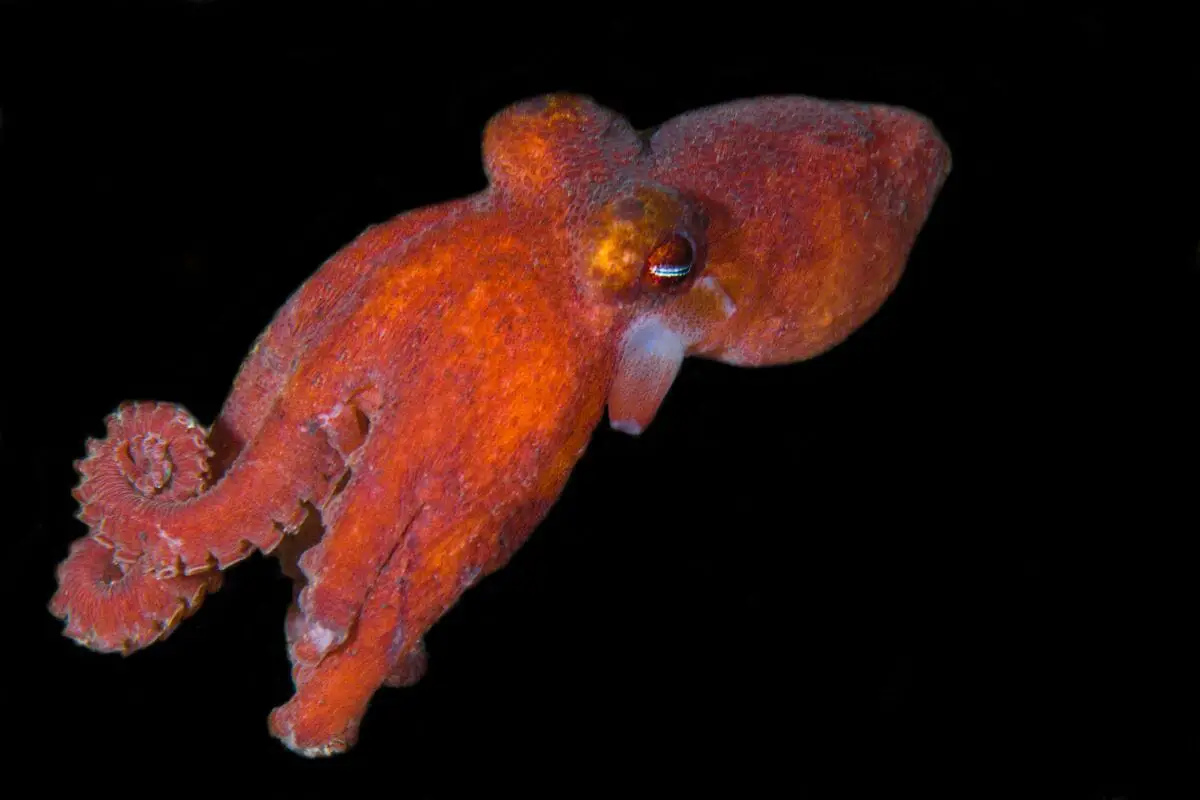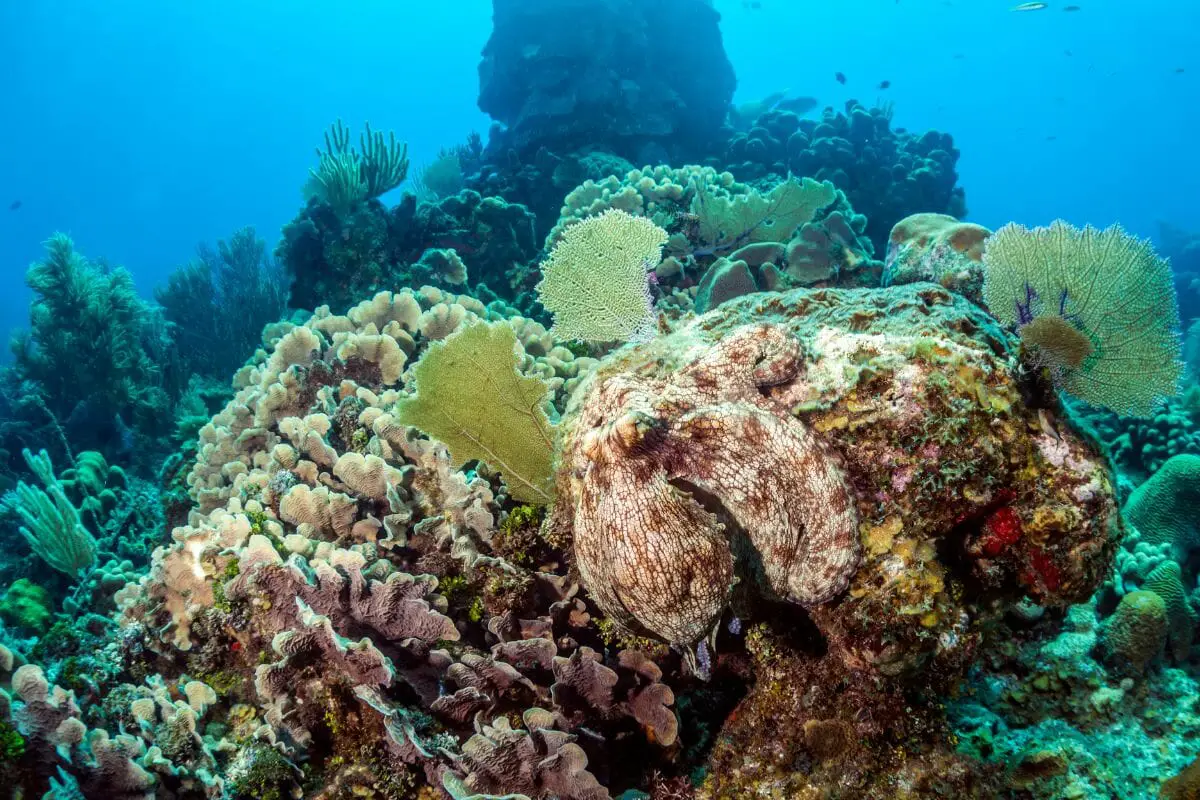Since Paul the octopus started to forecast the results of some major soccer matches, octopuses have become famous.

Well known for their eight tentacles and soft body, these beautiful animals have a unique appearance, and even children often recognize an octopus when they see one.
Octopuses belong to the class Cephalopoda, and each of the 300 octopus species has slightly different features and characteristics.
We take a look at nine very different types of octopus, and what makes them special.
Common Octopus

When we imagine an octopus, then it is likely the common octopus (Octopus vulgaris).
Out of all the known octopus species studied so far, this is the best known and widely distributed octopus.
This eight-limbed mollusk lives in temperate, subtropical and tropical water, all the way from the South coast of South Africa to the Eastern Atlantic.
Although its description as “common” doesn’t sound like much, this animal is surprisingly intelligent and smart.
Studies have shown that common octopuses can solve mazes, and they can even escape from closed containers.
They are often considered to be the most intelligent of all invertebrates.
Giant Pacific Octopus

With a weight of around 150 pounds, the giant Pacific octopus (Enteroctopus dofleini) is the largest species in the world.
This reflects not only in its weight but also its length which is around 15 feet.
Like some other octopus species, this large mollusk can also change its color to blend in with its surroundings.
This helps the animal to stay invisible from predators.
The giant Pacific octopus lives almost anywhere from 6,600 feet below the water’s surface to tide pools where they hunt fish, other octopuses and crustaceans.
Coconut Octopus

This octopus doesn’t get its name from its appearance but its behavior.
A coconut octopus (Amphioctopus marginatus) has been observed to collect coconut shells, and use them as a shelter and for defense.
Similar to snails, the coconut octopus even carries the “shell” when it’s moving around.
Then, it uses six tentacles to hold onto the shell, and it walks along the floor with the remaining two arms.
Dumbo Octopus
There are actually a number of different deep-sea octopus species that are assigned to the class of dumbo octopus (Grimpoteuthis).
This type of octopus has fins that look similar to the ears of the famous Disney elephant Dumbo.
Although these fins are also found in their cousins, the smaller Cirrina, researchers believe that this octopus species has a coiled body.
Dumbo octopuses commonly live in depth of around 13,000 feet. Although their body size is relatively small, they can get up to six feet in length.
One thing that Dumbo octopuses do not have compared to many other Cephalopods is an ink sack.
Scientists believe that this is because they do encounter a large number of predators in the deep sea.
Blue-Ringed Octopus

This must be one of the most beautiful octopus species. The blue-ringed octopus (Hapalochlaena) is well-known for its striking, azure spots.
But don’t let the pretty colors fool you. When this octopus shows you his spots, he is ready to attack with his venom.
Researchers found that the venom of this octopus is a thousand times stronger than cyanide (just as a comparison, this could 26 humans).
This is the reason why the blue-ringed octopus is one of the most dangerous creatures in oceanic waters.
Atlantic Pygmy Octopus

Just as its name suggests, the Atlantic pygmy octopus (Octopus joubini) is one of the smallest octopus species. It measures just six inches long.
Despite its size, this octopus species is particularly clever. It uses shells and other objects in the ocean to camouflage itself and hide in.
It is also a surprisingly smart hunter. With a sharp radula, it drills tiny holes into its prey (such as crustaceans) and then excretes toxic saliva inside.
This paralyzes the victim and the octopus has enough time to enjoys its meal.
Mimic Octopus

The mimic octopus (Thaumoctopus mimicus) has a particularly unique feature that makes it unusual amongst other octopus species.
Namely, it can impersonate other sea creatures by changing its body shape and color.
This octopus has been observed to transform itself into fifteen different animals, (see also: Animals That Transform)from shrimp and jellyfish to sea snakes and crabs.
It is believed that this behavior helps the octopus to evade predators by pretending that it is one of their kind.
Caribbean Reef Octopus

Octopuses are master in disguise but each species has its own particular tricks.
The Caribbean reef octopus (Octopus briareus) can change its patterns, colors and skin texture to seamlessly blend in with its surrounding environment.
This is a handy superpower when the animal is trying to hide from predators, such as sharks and large bone fish.
This nocturnal octopus hunts for crustaceans and fish only at night.
Seven-Arm Octopus
When you look at a seven-arm octopus (Haliphron atlanticus), you might be somewhat confused about the name because these octopuses actually have eight arms.
The misinterpretation of the name comes the fact that the male octopuses of this species have a smaller arm which is used for egg fertilization.
It is hidden in a sac underneath the animal’s eyes.
The seven-arm octopus is almost as large as a Pacific giant octopus but it is typically found only in deep-sea waters.
That’s why, it is somewhat of an elusive creature as it hasn’t been spotted by scientists very often.
However, on one of these excursions, a seven-armed octopus was found eating a jellyfish which is an unusual meal for an octopus.
Final Thoughts
While octopuses do have any bones, they make up for this lack with their incredible intelligence.
The many different types of octopuses prove that they are one of the smartest creatures in the world.
They use tools, such as coconut shells, to hide in and defend themselves.
Researchers also believe that they can memorize information for months, and they can even recognize creatures outside their own species.
But octopuses are not just smart animals, they are also emotional creatures that have been shown to feel excitement and affection.
- What Should I Do If A Koala Bites Me? Safety Guide - 2024-05-30
- Are Kangaroos Born Without Hind Legs? A Fascinating Journey - 2024-05-30
- Animals That Look Like Squirrels - 2024-05-30








